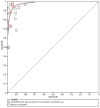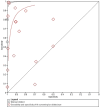Artificial intelligence versus manual screening for the detection of diabetic retinopathy: a comparative systematic review and meta-analysis
- PMID: 40400628
- PMCID: PMC12092458
- DOI: 10.3389/fmed.2025.1519768
Artificial intelligence versus manual screening for the detection of diabetic retinopathy: a comparative systematic review and meta-analysis
Abstract
Background: Diabetic retinopathy is one of the leading causes of blindness globally, among individuals with diabetes mellitus. Early detection through screening can help in preventing disease progression. In recent advancements artificial Intelligence assisted screening has emerged as an alternative to traditional manual screening methods. This diagnostic test accuracy (DTA) review aims to compare the sensitivity and specificity of AI versus manual screening for detecting diabetic retinopathy, focusing on both dilated and un-dilated eyes.
Methods: A systematic review and meta-analysis were conducted for comparison of AI vs. manual screening of diabetic retinopathy using 25 observational (cross sectional, validation and cohort) studies with total images of 613,690 used for screening published between January 2015 and December 2024. Outcomes of the study was sensitivity, and specificity. Risk of bias was assessed using the QUADAS-2 tool for validation studies, the AXIS tool for cross-sectional studies, and the Newcastle-Ottawa Scale for cohort studies.
Results: The results of this meta-analysis showed that for un-dilated eyes, AI screening showed pooled sensitivity of 0.90 [95% CI: 0.85-0.94] and pooled specificity of 0.94 [95% CI: 0.91-0.96] while manual screening shows pooled sensitivity of 0.79 [95% CI: 0.60-0.91] and pooled specificity of 0.99 [95% CI: 0.98-0.99]. For dilated eyes the pooled sensitivity of AI screening is 0.95 [95% CI: 0.91-0.97] and pooled specificity is 0.87 [95% CI: 0.79-0.92], while manual screening sensitivity is 0.90 [95% CI: 0.87-0.92] and specificity is 0.99 [95% CI: 0.99-1.00]. These data show comparable sensitivities and specificities of AI and manual screening, with AI performing better in sensitivity.
Conclusion: AI-assisted screening for diabetic retinopathy shows comparable sensitivity and specificity compared to manual screening. These results suggest that AI can be a reliable alternative in clinical settings, with increased early detection rates and reducing the burden on ophthalmologists. Further research is needed to validate these findings.
Systematic review registration: https://www.crd.york.ac.uk/PROSPERO/home, CRD42024596611.
Keywords: artificial intelligence; automated detection; deep learning; diabetic retinopathy; manual screening; screening.
Copyright © 2025 Tahir, Ullah, Tahir, Domnic, Prabhakar, Meerasa, AbdElneam, Tahir and Ali.
Conflict of interest statement
The authors declare that the research was conducted in the absence of any commercial or financial relationships that could be construed as a potential conflict of interest.
Figures









Similar articles
-
Pivotal Evaluation of an Artificial Intelligence System for Autonomous Detection of Referrable and Vision-Threatening Diabetic Retinopathy.JAMA Netw Open. 2021 Nov 1;4(11):e2134254. doi: 10.1001/jamanetworkopen.2021.34254. JAMA Netw Open. 2021. PMID: 34779843 Free PMC article. Clinical Trial.
-
Artificial Intelligence Detection of Diabetic Retinopathy: Subgroup Comparison of the EyeArt System with Ophthalmologists' Dilated Examinations.Ophthalmol Sci. 2022 Sep 30;3(1):100228. doi: 10.1016/j.xops.2022.100228. eCollection 2023 Mar. Ophthalmol Sci. 2022. PMID: 36345378 Free PMC article.
-
Evaluation of Artificial Intelligence Algorithms for Diabetic Retinopathy Detection: Protocol for a Systematic Review and Meta-Analysis.JMIR Res Protoc. 2024 May 27;13:e57292. doi: 10.2196/57292. JMIR Res Protoc. 2024. PMID: 38801771 Free PMC article.
-
Performance of artificial intelligence in diabetic retinopathy screening: a systematic review and meta-analysis of prospective studies.Front Endocrinol (Lausanne). 2023 Jun 13;14:1197783. doi: 10.3389/fendo.2023.1197783. eCollection 2023. Front Endocrinol (Lausanne). 2023. PMID: 37383397 Free PMC article.
-
Imaging based artificial intelligence for predicting lymph node metastasis in cervical cancer patients: a systematic review and meta-analysis.Front Oncol. 2025 Feb 28;15:1532698. doi: 10.3389/fonc.2025.1532698. eCollection 2025. Front Oncol. 2025. PMID: 40094016 Free PMC article.
References
-
- World Health Organization . Global report on diabetes. Geneva: World Health Organization; (2016).
-
- World Health Organization . (2023) Blindness and visual impairment fact sheet. Available online at: https://www.who.int/news-room/fact-sheets/detail/blindness-and-visual-im...
Publication types
LinkOut - more resources
Full Text Sources

